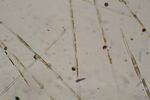New research from West Coast oceanographers provides insight into the cause of toxic algae blooms that caused shellfish closures and marine mammal deaths near the Oregon-California border.
The study, published in the journal Frontiers in Climate, shows climate change and a 2013-2015 Pacific Ocean heatwave, often called “the blob,” have together increased the growth of toxic algae off the coastline from Cape Mendocino, California to Cape Blanco, Oregon.
“The 2015 warm anomaly populated or seeded this new site, which now is a new source of toxin to contaminate shellfish on our coast,” said Dr. Vera Trainer, a research oceanographer at NOAA’s Northwest Fisheries Science Center and the study’s lead author.
After 2015, there were persistent clam and crab closures on the Northern California and Southern Oregon coast, Trainer said. The research confirmed the warm water temperatures seeded algae that were protected from ocean currents and stored in sediment at this new hotspot off of Trinidad, California.
Pseudo-nitzschia algae produce a neurotoxin called domoic acid that are consumed by filter-feeding shellfish. In addition to shellfish closures in the region, the toxins pose a threat to marine wildlife like sea lions, sea otters and whales. Sardines and anchovies retain high levels of the toxins though, Trainer says, they don’t seem to be affected.

Pseudo-nitzchia is a form of diatom that produces the toxin domoic acid that can accumulate in shellfish. This sample was collected off the coast of Oregon in May 2015.
NOAA Fisheries/NWFSC
The marine heatwave that caused the algae growth was five times more likely to have occurred from human-caused climate change than natural influences, according to a related study cited in the paper.
Now that the researchers understand the cause of the algal blooms, Trainer and her colleagues are working with coastal managers to create harmful algal bloom bulletins to provide early warnings to the public and allow for more targeted marine fisheries closures, rather than widespread restrictions.
“We can provide a short-term forecast, sort of like a weather forecast, that projects out three to five to seven days what the risk is for the harmful algae to come to the coast,” Trainer said.
She said the toxicity at sites like Trinidad will come and go with ocean upwelling and currents. She hopes their new forecasting tools will help residents and fisheries adapt.
“By knowing that hot spot is there, we’re going to be able to monitor it more closely,” she said. “Our hope is that we will be able to work with managers to provide early warnings.”